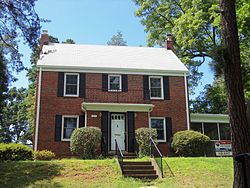United States historic place
| Highland Park–Overlee Knolls | |
| U.S. National Register of Historic Places | |
| U.S. Historic district | |
| Virginia Landmarks Register | |
 | |
   | |
| Location | Roughly bounded by 22nd St. N., N. Lexington St., 16th St. N., N. Longfellow St., McKinley Rd., I-66 & N. Quantico St., Arlington, Virginia |
|---|---|
| Coordinates | 38°53′12″N 77°08′49″W / 38.88667°N 77.14694°W / 38.88667; -77.14694 |
| Area | 180.7 acres (73.1 ha) |
| Built | 1890 (1890)-c. 1960 |
| Architectural style | Queen Anne, Italianate, Colonial Revival, Craftsman, Tudor Revival, and Modern Movement |
| MPS | Historic Residential Suburbs in the United States, 1830-1960 MPS |
| NRHP reference No. | 11000548 |
| VLR No. | 000-9703 |
| Significant dates | |
| Added to NRHP | August 18, 2011 |
| Designated VLR | June 16, 2011 |
Highland Park–Overlee Knolls, also known as Fostoria, is a national historic district located in Arlington County, Virginia. It is directly east of the Virginia Heights Historic District. It contains 681 contributing buildings, 3 contributing sites, and 1 contributing structure in a residential neighborhood in North Arlington. The first subdivision was platted in 1890 and known as Fostoria.

The company, which was seen in advertisements as Fostoria Land and Improvement Company, was incorporated in November 1890. William E. Abbott served as president, with James M. Hoge as secretary, and Madison A. Ballinger acting as the real estate broker. Madison A. Ballinger was active in Washington, D.C., society. His house was decorated in red, white and blue, in honor of the Daughters of the American Revolution, of which his wife was the President of the Continental Chapter.
Later subdivisions of Fostoria were platted including Over-Lee Knolls (1926), Section Two Over-Lee Knolls (1927), Richmond Hill Section Three (1946), Richmond Hill Section Four (1947) and Highland Park Village (1947). It primarily consists of single family dwellings in a number of popular architectural styles including Queen Anne, Italianate, Colonial Revival, Craftsman, Tudor Revival, and Modern-style. Also located in the district is Parkhurst Park (1939). The houses were built by multiple developers and speculative builders.
It was listed on the National Register of Historic Places in 2011.
References
- ^ "National Register of Historic Places Listings". Weekly List of Actions Taken on Properties: 8/15/11 through 8/19/11. National Park Service. August 26, 2011.
- "Virginia Landmarks Register". Virginia Department of Historic Resources. Retrieved May 12, 2013.
- Hinman, Ida (1895). The Washington Sketch Book. p. 108.
 This article incorporates text from this source, which is in the public domain.
This article incorporates text from this source, which is in the public domain.
- L. Trieschmann & M. Dayton, A. Schoenfeld & J. Barnes (October 2010). "National Register of Historic Places Inventory/Nomination: Highland Park–Overlee Knolls" (PDF). and Accompanying six photos
This article about a property in Arlington County, Virginia on the National Register of Historic Places is a stub. You can help Misplaced Pages by expanding it. |
- Houses on the National Register of Historic Places in Virginia
- Brick buildings and structures in Virginia
- Queen Anne architecture in Virginia
- Italianate architecture in Virginia
- Colonial Revival architecture in Virginia
- Tudor Revival architecture in Virginia
- Historic districts on the National Register of Historic Places in Virginia
- National Register of Historic Places in Arlington County, Virginia
- Houses in Arlington County, Virginia
- Northern Virginia Registered Historic Place stubs
- Arlington County, Virginia, geography stubs

